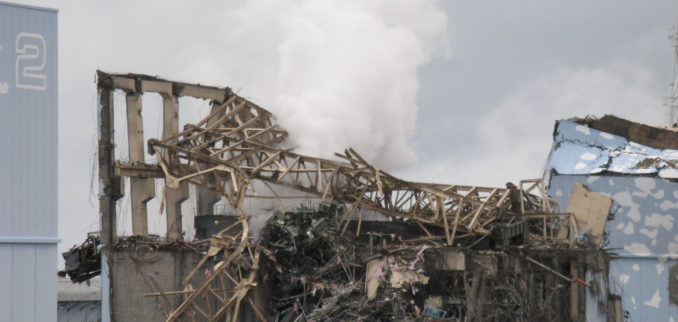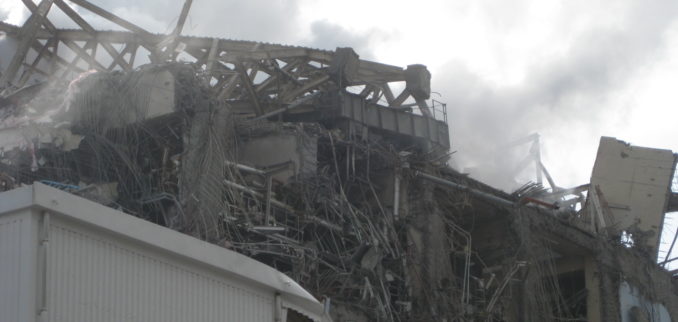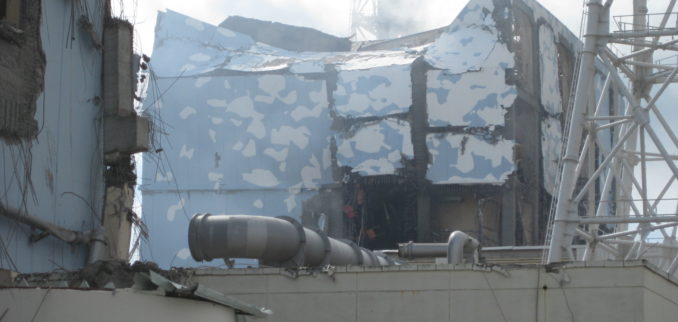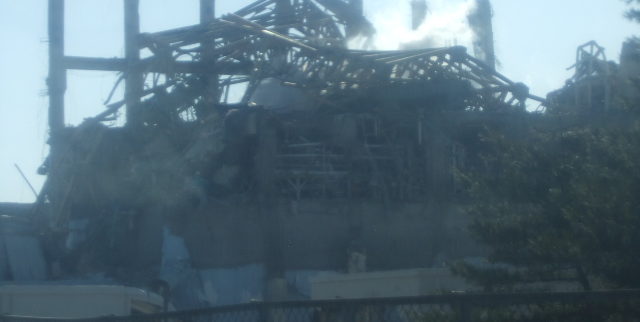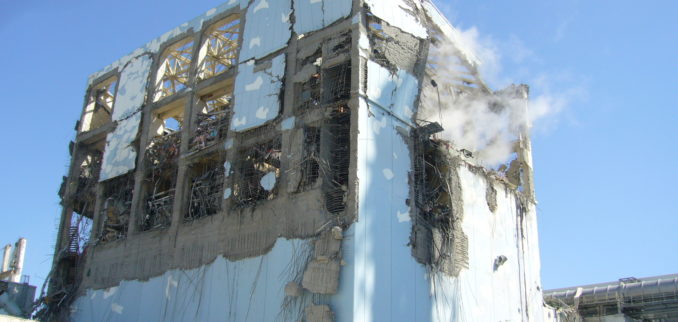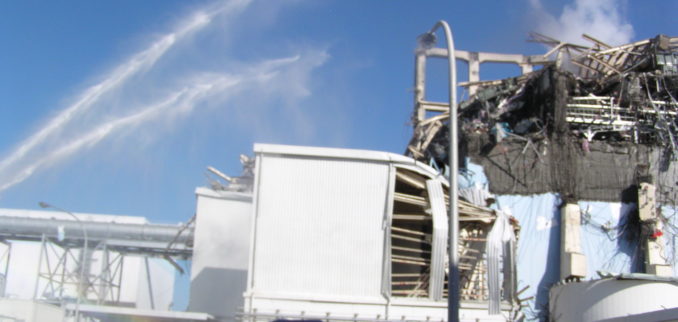Ten Years on from Fukushima (1/6): The lead-up to the 2011 Disaster
Image source: Tepco
After Chernobyl, the Fukushima accident of 11 March 2011 is history’s most serious reactor accident. An expert team from ENSI carried out an in-depth analysis of the circumstances leading up to the disaster. As a result, ENSI was able to derive important conclusions both for its own regulatory role and for the safety of Swiss nuclear installations.
Ten years ago, a very strong earthquake and the subsequent tsunami destroyed the Fukushima-Daiichi Nuclear Power Plant (NPP). Safety systems failed and in several reactor units, the result was a core meltdown and the release of considerable quantities of radioactive substances. The reactor disaster in Fukushima, Japan on 11 March 2011 was classified as an INES 7 level accident – up until then, the accident in Chernobyl, Ukraine in 1986 had been the only accident to have been classified as the highest level, “Major Accident”, on the international event scale.
The events of the 11 March 2011 alarmed NPP operators, authorities and politicians all over the globe: how well were nuclear installations really prepared to overcome hazards and dangers? ENSI too carried out an in-depth investigation into how, in Japan, the natural disaster could have resulted in the nuclear reactor disaster.
Timeline of the catastrophic accident
- Prior to the events of 11 March 2011, units 1, 2 and 3 of the Fukushima-Daiichi NPP were in power operation mode, while units 4, 5 and 6 were shut down for overhaul and backfitting.
- At 14:46 local time (6:46 CET), automatic scrams (emergency reactor shutdowns) were triggered for units 1 to 3. This stopped the nuclear chain reaction. As the main power supply to the power plant’s systems failed, the emergency diesel generators were started up. According to the licensee, TEPCO, in doing so, the units had reacted as per their design, that is as intended in such cases.
- At 14:49, the first tsunami warning was received in respect of an expected flood level of three metres, two further warnings followed (at 15:14 in respect of a flood level of six metres, then at 15:30 in respect of a ten-metre flood level). The first wave reached the north east coast of Japan and thus the site of the power plant at 15:27.
- The second wave with an actual height of between 14 and 15 metres first flooded parts of the site at 15:35 (the tsunami flood protection wall was designed for a maximum wave height of 5.7 metres) and then shortly thereafter, flooded key parts of the infrastructure, which were protected up to a height of ten metres. Affected amongst other systems and equipment, were the nuclear auxiliary cooling water systems and various items of safety equipment.
- As a result of the flooding, the emergency diesel generators also failed because they were neither bunkered nor positioned at a higher level. Consequently, the emergency power supply was also lost in units 1 to 4 resulting in a station blackout and loss of the power supply necessary for cooling the fuel elements in the reactor cores and the spent fuel pools.
- At 15:42 a state of emergency was declared in Fukushima-Daiichi. The site was flooded for 22 minutes.
- The functioning of a number of safety systems was disrupted or compromised by the tsunami. Subsequently, the filling level in the reactor pressure vessels of reactor units 1 to 3 fell. A whole series of accidents followed – emergency measures failed: attempts to get systems working again or to cool the reactor cores and the containment to at least some extent with seawater, did not occur or failed.
- Hydrogen explosions and subsequent fires further obstructed the affected reactor buildings (units 1 to 4) and either hampered emergency work or rendered it impossible. The core meltdowns (units 1 to 3) and the release of radioactivity (units 1 to 3 at a high level and unit 4 to a lesser degree) were not prevented. The fuel rods in unit 1 had melted as early as the first evening following the earthquakes and the tsunami.
- The emergency power supply also failed extensively in units 5 and 6. Nevertheless, it was possible to avert extensive fuel damage with the help of the one remaining emergency diesel generator which safeguarded the power supply to the residual heat removal pumps so that, after an interruption, the spent fuel pools could once again be cooled.
ENSI’s Fukushima analysis in detail
Even before the Fukushima disaster, the nuclear installations in Switzerland already had very high safety levels. In contrast to the plant in Fukushima, they have specially bunkered emergency systems, that are particularly well protected against external influences. Furthermore, the hazard analyses for severe natural events such as earthquakes or flooding in Switzerland have been, and continue to be, regularly updated using the latest methods, and the safety of nuclear power plants is periodically comprehensively reviewed and improved.
To understand the consequences and complexity of the events in Fukushima, and to derive any possible need for action in respect of the safety of Swiss nuclear installations, an interdisciplinary analysis team was formed within ENSI: experts from the fields of safety analysis, human & organisational factors, radiation protection, electrical engineering, mechanical engineering, materials science, and systems engineering came together to form the “Japan Team”. The Japan Team compiled six reports on the events and their consequences:
- Course of Events (2011)
- Accident Analysis Focussing on Human and Organisational Factors (2011)
- Lessons Learned and Inspection Points Derived for Switzerland (2011)
- The Radiological Effects (2011)
- Report on the Human and Organisational Factors, Part I (2015) and Part II (2018) (Part III in Progress)
The strong earthquake off Japan caused the loss of the external power supply and triggered a tsunami with a wave height of 14 to 15 meters. The tsunami caused a station blackout at on the Fukushima-Daiichi site. Failure of the core cooling (unit 1), containment cooling (units 1 to 3) and the spent fuel pool (unit 4) were the direct consequences; they were critical in the further accident sequence.
The failure of the core cooling in units 2 and 3 occurred more than a day later – the initially operating (steam-driven) core cooling systems were not designed to operate for a prolonged period of time, and emergency measures to switch to alternative core cooling systems were not implemented soon enough. The reactor cores (units 1 to 3) overheated and core material melted. Hydrogen explosions destroyed the reactor buildings in units 1, 3 and 4, damaged the reactor building in unit 2 and allowed radioactive substances to escape uncontrolled and in significant quantities into the environment.
On the evening of 11 March 2011, the population within a radius of three kilometres was evacuated, while from 5AM the next morning evacuation from with a radius of ten kilometres took place, and on the evening of 12 March from within a radius of 20 kilometres. In the following months, still further areas were evacuated due to radiation exposure.
Multiple deficiencies linked together
ENSI considers the main reasons for the accident at the Fukushima-Daiichi NPP to be the inadequate engineering design to protect against tsunamis, especially as a result of earthquakes, the incorrect evaluation of the hazard and deficiencies in the provisions for combating beyond-design-basis accidents (in respect of instructions and equipment). However, the analysis of the circumstances also revealed a number of structural deficiencies that had an influence on the inadequate safety provisions: the lack of independence of the regulator, inadequate safety awareness on the part of the operator and the authorities, insufficient regulatory requirements and inadequate legal anchoring of emergency preparedness and response. The nuclear branch worldwide learnt lessons from the mistakes.
In Switzerland too, nuclear energy and radiation safety legislation have been revised. Moreover, internationally, the sharing of feedback from experience was stepped up and emergency precautions expanded. NPPs had to provide further proofs and carry out backfittings in order to meet the increased safety requirements in respect of earthquakes, flooding, power and cooling water provision. In addition, a comprehensive new analysis of the risk of flooding of the river Aare was undertaken (Project EXAR), initiated by the Federal Office for the Environment (FOEN) and carried out according to the latest state of the art of science and technology. Moreover, ENSI allowed its regulatory activities to be inspected by a team of international experts, while the Swiss NPPs had to withstand a European safety comparison (EU Stress Test and follow-ups). In the first EU stress test after the events in Fukushima, the Swiss NPPs scored well. Nevertheless, safety evaluation is an ongoing process.
Videos (with english subtitles)
This is the first part of an ENSI series marking the tenth anniversary of the Fukushima disaster of 11 March 2011. The second part covers the radiological impacts of the accident and will be published on 11 February 2021.


